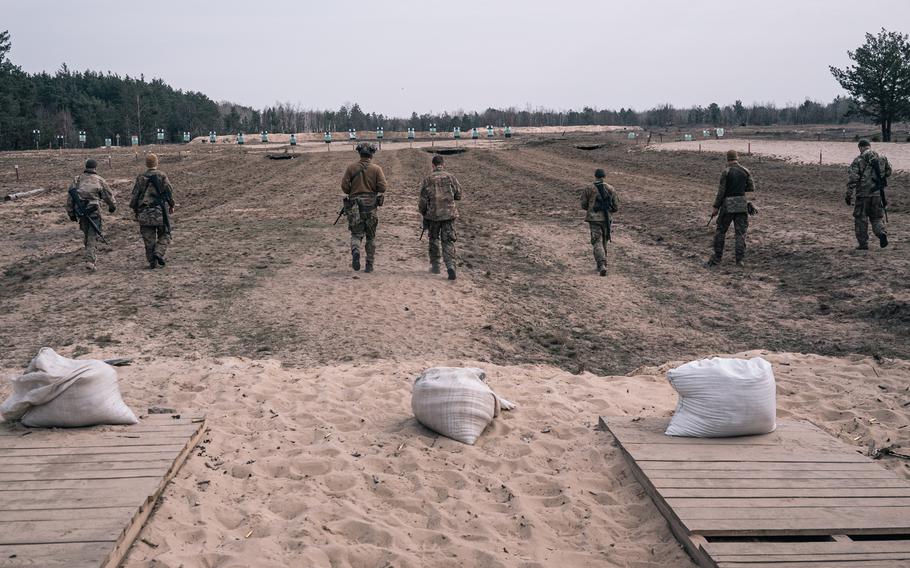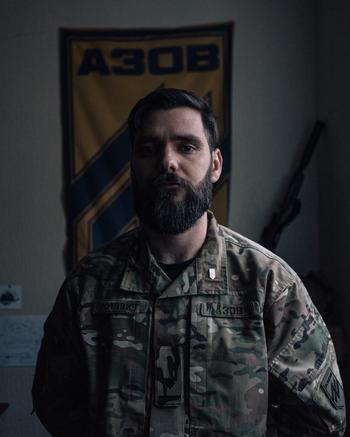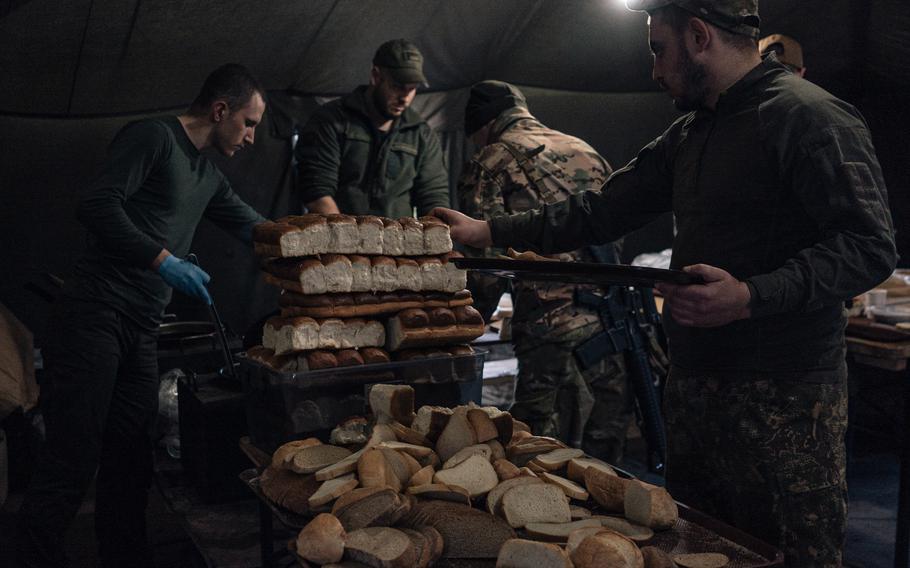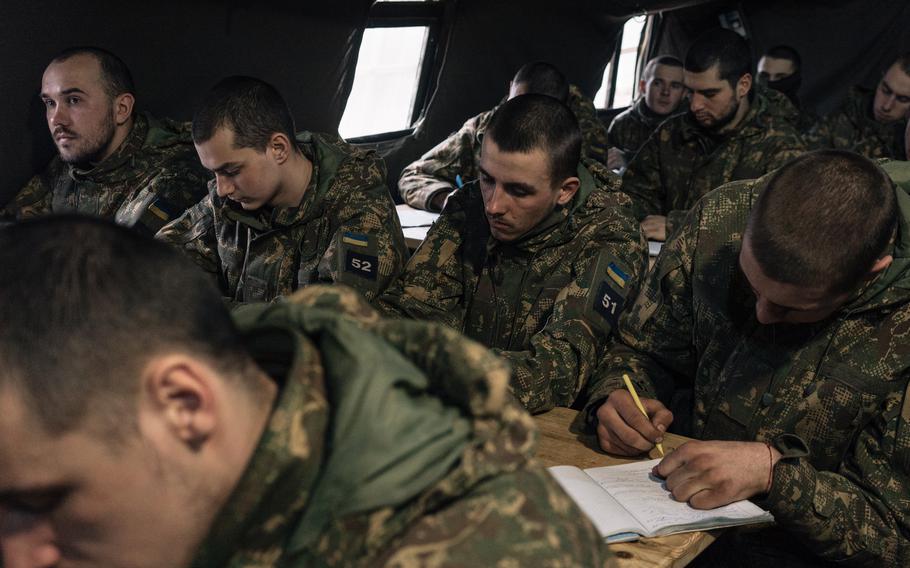Europe
Ukraine’s Azov brigade races to rebuild ahead of fateful fight
The Washington Post April 26, 2023

New recruits attend shooting practice at an Azov Brigade training camp outside Kyiv, Ukraine, on March 24, 2023. (Alice Martins/for The Washington Post)
KYIV, Ukraine — The Azov brigade, hailed by Ukrainians for its tenacity during Russia’s siege of Mariupol, is scrambling to rebuild from heavy combat losses as it seeks to play a muscular role in Ukraine’s next major assault.
The high-profile unit is hoping to recruit 6,500 new fighters who will provide restored combat heft even as its leaders push for the return of more than 1,000 brigade troops who remain in Russia as prisoners of war.
“We are ready to liberate territory,” Maj. Bohdan “Tavr” Krotevych, who is the brigade’s interim commander and is leading the rebuilding effort after his release from Russian captivity in the fall, said in an interview.
The Ukrainian government has designated Azov, which recently absorbed other elements of the country’s National Guard, as one of six “offensive brigades” that will help spearhead Ukraine’s attempt to recapture Russian-occupied areas.
After months of largely static front lines, the spring fighting season will be crucial as Ukraine aims to prove that it can hold out against Russia and is still worthy of support from outside backers who have poured billions of dollars’ worth of weaponry into the fight.
Brigade leaders are also seeking to move past the controversy surrounding Azov’s far-right roots, which has resulted in the unit being barred from receiving Western weapons, potentially curtailing its abilities.
The newest recruits are drawn to Azov not for the ultranationalist ideology of its origins but for its proven combat skill, brigade leaders say.
“It is a name that, thanks to the defense of Mariupol, became known to the world,” a 28-year-old master sergeant, who goes by the call sign Maslo, said at a recent training session outside Kyiv. “It was known in a certain negative way,” Maslo added. “Now it is in a positive way because what we do works ... The recruits coming to us understand that.”
Azov rose to prominence after Russian President Vladimir Putin’s illegal seizure of Crimea in 2014, as Ukraine’s ill-equipped military struggled to fight back against Russian-backed separatists in the eastern Donbas region. Azov, then a volunteer formation, had a key role in defending the strategic city of Mariupol. The unit was incorporated into Ukraine’s National Guard later that year.
After Russia’s February 2022 invasion, hundreds of Azov fighters held out for weeks beneath Mariupol’s Azovstal steel plant, along with stranded civilians. They persisted without adequate food and medicine amid a massive Russian bombing campaign, which elevated Azov and other Mariupol defenders to what Ukraine’s military command called “heroes of our time.”
In May, hundreds of wounded troops were evacuated. A few days later, military commanders ordered the remaining Azovstal troops to surrender, ending the siege.
Krotevych, who was among some 900 captured Azov fighters, spent the initial days as a prisoner of war at Olenivka, a filtration center in Russian-controlled Donetsk region, where several months later dozens of Azov fighters were killed in an attack Russia and Ukraine blamed on each other.
Krotevych spent the next four months in solitary confinement near Moscow, until he was released in September as part of a major prisoner swap brokered by Turkey and Saudi Arabia. Under that deal, 215 Ukrainians, including more than 100 Azov fighters, and a group of foreign nationals were released in exchange for Viktor Medvedchuk, a pro-Kremlin Ukrainian opposition politician, as well as Russian fighters.
Two weeks after his return to Ukraine, Krotevych returned to the unit.
While most of the released POWS returned to the unit, over 1,000 Azov personnel, including fighters absorbed from another brigade, remain imprisoned in Russia. They represent about a fifth of the roughly 6,000 Ukrainians now being held there as POWs, Krotevych said.
Unit leaders have unsuccessfully advocated more exchanges. “I came to the conclusion that the fastest way to release our prisoners is to take more Russian soldiers prisoner, and to end this war with our victory,” Krotevych said.
In Kyiv, a massive banner hanging on Khreshchatyk Street in the city’s center that reads “Free Azovstal defenders” is a testament to the feelings of many Ukrainians. Yet the unit’s conduct against Russia has not entirely eclipsed the controversy around its ultranationalist history and links to figures who have espoused xenophobic and racist views.
Azov leaders have denied allegations of fascism and racism.
Still, Azov has long featured in messaging by Putin and other Russian leaders about their goal of “de-Nazifying” the country. In 2022, Russia’s top court officially designated Azov a terrorist group.
Krotevych said the unit has no political ambitions and conducts investigations into any cases of far-right extremism it identifies. “As a military unit, we share the position of the state and the government,” he said.

Maj. Bohdan “Tavr” Krotevych, acting commander of the Azov brigade, was released from Russian captivity in the fall and is leading the effort to rebuild the Ukrainian unit. (Alice Martins/for The Washington Post)
Krotevych said that Russia had labeled all of those who have taken up arms to defend Ukraine as dangerous “nationalists.”
Michael Colborne, who wrote a book about the Azov movement and leads Bellingcat’s work on the global far right, said the unit’s focus appears to have shifted over time from ideology to military effectiveness.
He said that any remaining far-right elements within Azov probably would continue to be “diluted” as the unit grows and that the issue had become less important as Ukraine confronts an existential threat. “In Ukraine, the term nationalist or patriot describes a heck of a lot of people right now,” Colborne said.
Earlier this year, Meta, the parent company for Facebook, removed Azov from a list of dangerous individuals and organizations, citing a distinction between the military group and the political movement.
Despite Azov’s apparent evolution, it receives virtually no weaponry from Western nations including the United States.
Recent U.S. laws prohibit the provision of “arms, training or other assistance to the Azov Battalion.” The measures come as lawmakers in both parties call for proper oversight of the huge amount of aid going to Ukraine.
A State Department spokesperson, who spoke on the condition of anonymity under rules set by the department, said the recent prohibitions had no practical effect because the Azov Battalion — which the department described as a nonstate “militia group” — has not existed in more than five years.
Azov now “is a different unit,” the spokesperson said. However, he added: “Ukraine has agreed not to direct U.S. support to any identified units of concern” such as Azov.
Sarah Harrison, a former Pentagon lawyer now at the International Crisis Group, said the State Department was being “too cute by half” in drawing a distinction between Azov’s paramilitary past and its current status. But Harrison also said that lawmakers should have been more precise given that they clearly did not intend to single out a unit that no longer exists.

Men eat lunch at an Azov training facility outside Kyiv. (Alice Martins/for The Washington Post)
One 21-year-old Azov recruit from the western city of Ternopil, who under brigade rules was not permitted to give his name, said he had waited months for a chance to join the brigade. The recruit, speaking at the training session, described the controversy over Azov’s roots as an “overblown story.”
“Probably the most motivated people come here,” he said. “I can be sure that my comrade-in-arms, he will be able to cover me, protect me. And I will do the same.”
Maslo, who was also captured by Russia last year and spent a month in the hospital recovering from injuries he suffered, said Azov’s resourcefulness could help compensate for its lack of advanced weaponry.
Azov, he said, “will invent something out of nothing.”
Unit leaders say recruitment is going well but declined to disclose precise numbers. Fully achieving those goals may be difficult more than a year into the fight, after Ukraine’s military has taken heavy losses.
“The majority would assume that the war will end quickly or somebody else will win it for us. This didn’t happen,” Krotevych said. “So, we’re trying to explain to the civilian population of the country that we need them to help us liberate territories.”
Asked about the coming offensive, Krotevych cited the First Russian-Chechen War, when Chechen forces adopted a strategy of capturing small Russian towns to use as leverage to recover Russian-held areas. He suggested Ukraine may do the same.
He said that Azov would draw on the ordeals of 2022 in future fighting. “Our Azovstal experience tells us that there are no situations with no way out,” he said.

Recruits attend a class on land mines during training. (Alice Martins/for The Washington Post)